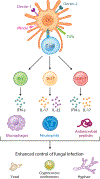Harnessing the Immune Response to Fungal Pathogens for Vaccine Development
- PMID: 35759871
- PMCID: PMC11926770
- DOI: 10.1146/annurev-micro-041020-111511
Harnessing the Immune Response to Fungal Pathogens for Vaccine Development
Abstract
Invasive fungal infections are emerging diseases that kill over 1.5 million people per year worldwide. With the increase of immunocompromised populations, the incidence of invasive fungal infections is expected to continue to rise. Vaccines for viral and bacterial infectious diseases have had a transformative impact on human health worldwide. However, no fungal vaccines are currently in clinical use. Recently, interest in fungal vaccines has grown significantly. One Candida vaccine has completed phase 2 clinical trials, and research on vaccines against coccidioidomycosis continues to advance. Additionally, multiple groups have discovered various Cryptococcus mutant strains that promote protective responses to subsequent challenge in mouse models. There has also been progress in antibody-mediated fungal vaccines. In this review, we highlight recent fungal vaccine research progress, outline the wealth of data generated, and summarize current research for both fungal biology and immunology studies relevant to fungal vaccine development. We also review technological advancements in vaccine development and highlight the future prospects of a human vaccine against invasive fungal infections.
Keywords: T cells; adaptive immunity; fungal infections; fungal vaccines; innate immunity; trained immunity.
Figures


Similar articles
-
A Heat-Killed Cryptococcus Mutant Strain Induces Host Protection against Multiple Invasive Mycoses in a Murine Vaccine Model.mBio. 2019 Nov 26;10(6):e02145-19. doi: 10.1128/mBio.02145-19. mBio. 2019. PMID: 31772051 Free PMC article.
-
Innate cells and STAT1-dependent signals orchestrate vaccine-induced protection against invasive Cryptococcus infection.mBio. 2024 Oct 16;15(10):e0194424. doi: 10.1128/mbio.01944-24. Epub 2024 Sep 26. mBio. 2024. PMID: 39324785 Free PMC article.
-
Coccidioidomycosis: host response and vaccine development.Clin Microbiol Rev. 2004 Oct;17(4):804-39, table of contents. doi: 10.1128/CMR.17.4.804-839.2004. Clin Microbiol Rev. 2004. PMID: 15489350 Free PMC article. Review.
-
Vaccine-Induced Immunological Memory in Invasive Fungal Infections - A Dream so Close yet so Far.Front Immunol. 2021 Apr 21;12:671068. doi: 10.3389/fimmu.2021.671068. eCollection 2021. Front Immunol. 2021. PMID: 33968079 Free PMC article. Review.
-
Vaccination with Recombinant Cryptococcus Proteins in Glucan Particles Protects Mice against Cryptococcosis in a Manner Dependent upon Mouse Strain and Cryptococcal Species.mBio. 2017 Nov 28;8(6):e01872-17. doi: 10.1128/mBio.01872-17. mBio. 2017. PMID: 29184017 Free PMC article.
Cited by
-
Cryptococcal Immune Reconstitution Inflammatory Syndrome: From Clinical Studies to Animal Experiments.Microorganisms. 2022 Dec 7;10(12):2419. doi: 10.3390/microorganisms10122419. Microorganisms. 2022. PMID: 36557672 Free PMC article. Review.
-
Will the Real Immunogens Please Stand Up: Exploiting the Immunogenic Potential of Cryptococcal Cell Antigens in Fungal Vaccine Development.J Fungi (Basel). 2024 Dec 4;10(12):840. doi: 10.3390/jof10120840. J Fungi (Basel). 2024. PMID: 39728336 Free PMC article. Review.
-
Vaccine Strategies for Cryptococcus neoformans.Methods Mol Biol. 2024;2775:411-422. doi: 10.1007/978-1-0716-3722-7_28. Methods Mol Biol. 2024. PMID: 38758334 Free PMC article.
-
Peripheral blood CD4+ and CD8+ T cell responses to Cryptococcus candidate vaccine antigens in human subjects with and without cryptococcosis.J Infect. 2025 Jul;91(1):106521. doi: 10.1016/j.jinf.2025.106521. Epub 2025 May 29. J Infect. 2025. PMID: 40449806
-
Immune responses to human fungal pathogens and therapeutic prospects.Nat Rev Immunol. 2023 Jul;23(7):433-452. doi: 10.1038/s41577-022-00826-w. Epub 2023 Jan 4. Nat Rev Immunol. 2023. PMID: 36600071 Free PMC article. Review.
References
-
- Bar E, Whitney PG, Moor K, Reis e Sousa C, LeibundGut-Landmann S. 2014. IL-17 regulates systemic fungal immunity by controlling the functional competence of NK cells. Immunity 40:117–27 - PubMed
Publication types
MeSH terms
Substances
Grants and funding
LinkOut - more resources
Full Text Sources
Medical

